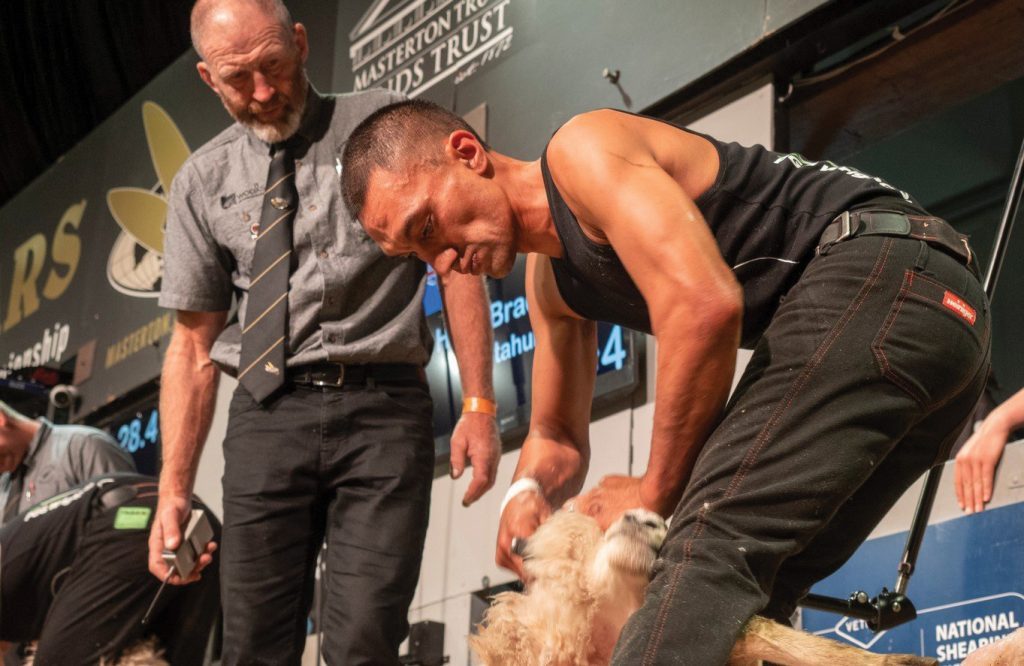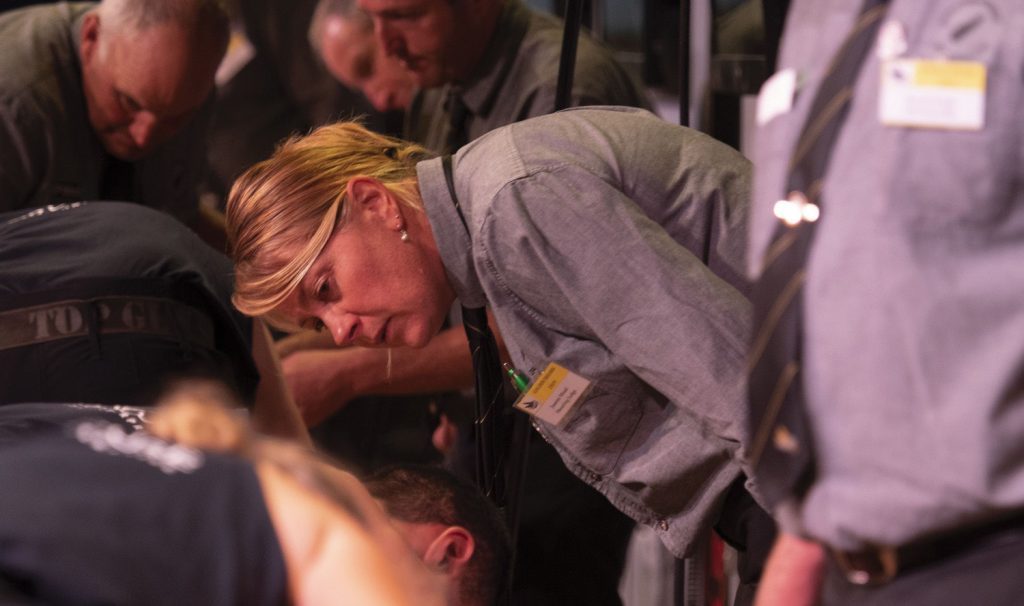A sheared interest
A North Canterbury couple have a joint interest in judging competition shearing. By Annabelle Latz.

A German shearer at a world championship once put his sheep on a stool, but usually, competitive shearing around the world looks similar.
Dave and Jo Brooker met as judges on the Canterbury circuit in 2013.
Jo has been a judge for 30 years, her father John was a judge and referee for many years around Nelson. Jo was one of the first female judges.
Jo’s initial involvement meant being among a familiar community of great people including her dad, while doing some community service. Sheep shearing judging was also a good contrast from the working week in the corporate world.
“Now there is education and training. The standards are more measurable now, there’s less variation in the judging.”
Jo and Dave judge competitive shearing and speed shearing competitions but not world record attempts, where a shearer aims to break the previous record tally over an eight- or nine-hour day, divided into four or five working ‘runs’. The current world record for strong wool ewes is 644 in eight hours held by new shearer Rowland Smith from Hawke’s Bay.
What a judge looks for in competitive shearing and speed shearing is similar, but how points and penalties are accrued varies.
A speed shear and a competition shear in the same town on a weekend encourages shearers and crowds. There is more money in speed shearing, and thrill because there is only one sheep, shorn as fast as possible to a strict quality standard.
All shearing competition rules are set by Shearing Sports New Zealand.
Competition shearing is more traditional, a combination of speed and quality, judged on quality, not style. Judges rotate around the board and out the back; the rule of thumb is that for every shearer there is one judge, and one additional judge for an extra set of eyes.
Out the back more skill is required, where the final word often sits where judges examine the amount of wool left on the sheep and cut marks.
At speed, judges on the board look for the second cut, which shearers want to avoid.
Shearers are Novice, Junior, Intermediate, Senior and Open, shearing between one and five sheep comparatively. Shearers begin their competition career in the section equivalent to how many sheep they shear in day in a woolshed.

There is an Open Blades section, which is dwindling as the number of blade shearers in NZ decreases.
They accrue one penalty for 20 seconds, but get penalised for lack of quality like cuts.
“It’s a matter of weighing these things up,” Jo says.
The further up the grades, the closer the shearers are in quality and speed. There is a favour in time, but the quality shearer can often pull through best.
In the lower grades it’s a 50-50 split men to women, but senior and open grades see mainly men.
In recent years there has been the introduction of women’s grades, and women can compete against the men too if they wish.
“As they go up the grades, women struggle to match men’s physicality,” Jo says.
Competitions mostly take place at A&P shows, sheep numbers ranging from 200 to 800. The annual Golden Shears and the Nationals are held in halls or stadiums, with 3500 sheep involved.
Competitor numbers range from between 30 and 50 for local competitions, to 200 for NZ competitions, Dave adding that in the 1970s and 1980s numbers were three times higher.
“There used to be 80 million sheep in NZ, there’s 20 million today. A lot fewer people are needed to shear sheep now,” Dave says.
It takes roughly 100 people to run a competition that involves 100 shearers. This includes truck drivers, the farmers who provide the sheep, stock shifting, judges, preparing the sheep, wool handlers, and pressers.
The wool gets processed and pressed, and the farmer will get it back.
“Shearing is generally done for free, and we often use the same time and time again,” Dave says, adding that it’s a massive event for the farmers who have to ensure the sheep are dry, and organise the transport and logistics to and from the farm.
“We value these farmers so highly.”
Crossbreds like Romney/Perendale have the best fleeces, and each year there is one crack for the NZ Merino title, Crossbred title, Corriedale title, and the lamb shear title which are usually Romney.
Nationwide there are about 70 competitions. Most shearers start in their late teens, taking about five years to reach Open grade, accruing points through competition wins and shed tallies.
“A junior shearer would take four to five minutes to shear two sheep, an open shearer would take four to five minutes to shear five sheep,” Dave says.
Jo enjoys seeing the shearers progressing through the grades, their personal confidence growing and their skill on the board.
Their hands shake so much with nerves when they start, it’s a wonder how they’re going to shear the sheep.
“It’s pretty cool seeing a junior shearer getting their first ribbon.”
She says they’re being judged for what they do, not who they are.
Judges get nervous too. Jo remembers her inaugural judging experience in Murchison, she dropped the counter in the competitor’s fleece.
“I just wanted the world to open up.”
They have judged at NZ’s top competitions including Golden Shears and NZ Shearing Championships, completing the three-year contract.
Judging teams qualifying for the Worlds at Canterbury A&P Show one year, Jo recalls realising her decision would partly decide the result.
“You actually realise what is at stake, the magnitude of the event. It is pretty cool.”

Jo lived a decade in Australia before heading home in 2013, and enjoyed judging on the Sydney circuit.
“The judging was similar, but not as well organised as it was in NZ.”
A shearer and a judge
Dave joined the world of competitive shearing as a competitor in the mid-1990s as a full-time shearer. A bit later in life compared to most, as he’d spent his 20s focusing on rugby “trying to be an All Black”, playing local senior level and for clubs abroad.
Dave still holds the hand piece, part time as a job and he’s a regular name in the local open classes, finishing in the top few but admits it’s hard to stack up against the elite shearers.
“Being a competitive person, competitive shearing was a natural progression.”
He finished last in intermediate class at his first show, but has come a long way, his best achievement making the Golden Shears senior final in his first five years of competition, finishing fifth out of a field of 60.
Dave was trying to get better every day in the sheds, and making the final is a real buzz.
“It’s not difficult to know what you have to do, what is difficult is actually doing it.”
He says some shearers make a good shed job, but are not good at competitive shearing.
Twenty years ago Dave started judging, as a way to exit competitive shearing. He didn’t achieve that, admitting competing is addictive. He now does both, judging the lower classes and competing in open class.
“It’s not ideal for either, but I’ve been doing it for 20 years so I’m used to it.”
He’s also been a part-time instructor and a highlight is seeing talent in young shearers he taught now as some of NZ’s best.
“Some shearers you can tell from the beginning they’re going to be good, quick to learn, that natural ability.”
He once took a shearing course at Christchurch Mens’ Prison, deemed a success and enjoyed by all.
“I like giving back to the sport, and I like the people involved too. You meet all sorts, like most sports.”
He says shearing is the ultimate sport, requiring a lot of physical fitness, rhythm, balance, hand/eye co-ordination, the ability to operate a piece of machinery that runs just right, while physically handling an animal.
“There are no other sports that do all those things. There’s not many jobs you take a sweat towel to work.”
Based in Sefton, North Canterbury, on a smallholding, the couple run Lifestyle Worx, a business specialising in lifestyle block work including shearing. Jo is the rousie.
Annually the NZ team travels to the United Kingdom for a tour, and world championships take place every three years. NZ has produced many world champion shearers, however for the first time failed to win an event at the recent World Championships in Scotland.
Dave and Jo managed the NZ Trans-Tasman team of three machine shearers, two blade shearers and two wool handlers to Australia in 2018, and the return leg in 2019. NZ won two of the three events in Australia and both events in 2019 (no blade shearing). They are both impressed with the quality of the sport in NZ, but did concede it’s not as big any more. Contractors are less willing to give their workforce a Saturday off to go to a competition, especially if it’s busy.
Full-time shearing is an unofficial prerequisite to enter the sport, and it’s a great hobby for retired shearers, who enjoy a bit of pocket money and the camaraderie. Prize money can range from about $150 to $3000, plus any sponsor products.
Elite shearers travel the NZ circuit, a good way to make a summer bonus.
The sport is great for the culture of shearing too, lifting the confidence of individuals, meaning they work harder out of the sheds too.
It gives younger shearers something to aspire to.




